



Strategic Bombers Overview
While the progressive development of SAC's surface-launched missile force was both important and
highly significant, it was by no means an isolated phenomenon. In most instances, it was paralleled
by qualitative improvements to the command's manned bomber force. When the Strategic Air
Command was first established on 21 March 1946 as one of the three major combat commands of
the United States Army Air Forces, its initial bomber force consisted of 148 veteran World War II
B-29 Superfortresses. Two years later, in 1948, this force was augmented with the first models of
two new bombers, the B-36 and the B-50. In 1951, the all jet-engine B-47 medium bomber made
its first appearance in SAC. This revolutionary aircraft was joined in 1955 by the first B-52
Stratofortress, destined to become the mainstay of the SAC manned bomber force into the 1990s.
Further additions to the SAC bomber fleet included the supersonic B-58 Hustler, introduced on 1
August 1960, and the FB-111A medium bomber accepted by SAC on 8 October 1969. The first operational B-1B joined the
command on 7 July 1985.
The growing maturity and sophistication of the SAC manned bomber force was matched by both
qualitative and quantitative improvements to the air defense systems of the leading communist
powers, especially the Soviet Union. This latter development over a thirty-year period led to SAC's
employment of a number of air-launched guided missiles to ensure that SAC's manned bombers
successfully penetrated enemy territory.
The bomber's unique strengths of payload, range, and responsiveness
coupled with precision attack are a cornerstone of America's airpower and force
projection. Prior to hostilities, bombers are a strong deterrent. When generated
for either conventional or nuclear alert, bombers provide a strong and highly
visible deterrent force just over the horizon from the enemy. During the initial
phases of a conflict, bombers launching from the United States with adequate
tanker support, can strike time-critical targets and stall the enemy attack
anywhere in the world. Delivering a large quantity and vast array of munitions,
our bomber force can attack an enemy's Weapons of Mass Destruction (WMD),
Command, Control and Communications (C 3 ) nodes, and advancing forces to
greatly reduce their effectiveness. The stand-off and stealth penetration
capability inherent in our bomber force allows them to operate with minimum
numbers of supporting operational assets during this initial phase. Utilizing
sustained forward-deployed operations, bombers provide increased firepower
while reducing the size of force packages and placing fewer aircrews at risk.
Should circumstances require, bombers can also provide rapid global response
without the need to deploy into theater before striking.
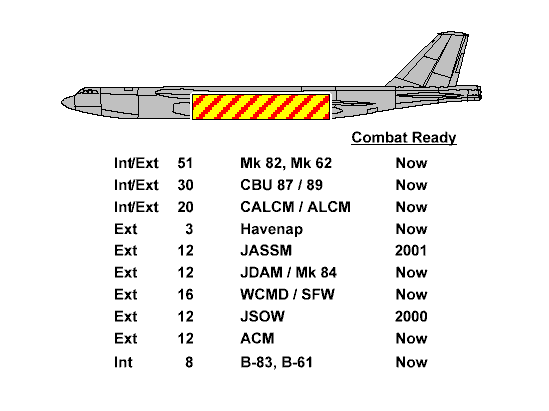
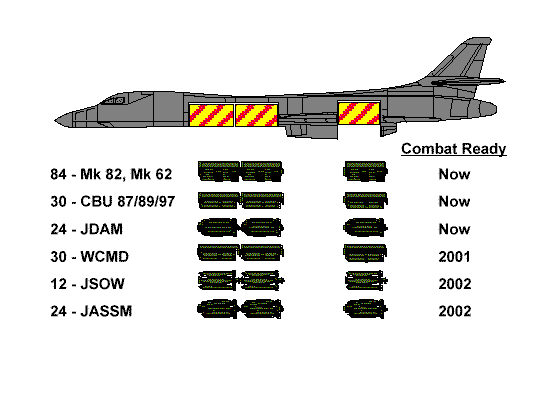
 Today’s force structure is largely a legacy of the Cold War when
intercontinental bombers were part of the Nuclear Triad to deter, and if
necessary, defeat the former Soviet Union. While part of the bomber force
continues to support the nuclear deterrent mission, the environment permits,
in fact demands, increased emphasis on conventional missions. The bomber
force structure required to prosecute two nearly simultaneous major theater
wars and contribute to a nuclear posture that deters aggression has been
defined by studies and national guidance. The 1993 Bottom-Up Review (BUR)
confirmed today’s bomber force structure requirement. Today’s sizing of forces
was built on the philosophy that the US should maintain sufficient military
power to be able to win two nearly simultaneous, major theater wars. The BUR
determined the bomber requirement by 1999 to include up to 184 total
bombers (combat coded), with the ability to deliver “smart” conventional
munitions against attacking enemy forces and fixed targets.
To support the imperative of engagement in the National Security
Strategy, the DoD laid out a National Military Strategy of Shape, Respond,
Prepare Now: A Military Strategy for a New Era. Details of the strategy and
resultant defense program in the May 1997 Report of the Quadrennial Defense
Review (QDR), prescribe a total fleet of 187 bombers (95 B-1, 21 B-2, and 71
B-52). Since the QDR, two B-1s have been lost in peacetime accidents.
However, the Report of the Panel to Review Long-Range Air Power (LRAP)
concluded the existing bomber fleet cannot be sustained through the expected
life of the air frames and that additional aircraft will eventually be required. To
address this issue, the Air Force will add five additional B-52 attrition reserve
aircraft, bringing the B-52 total from 71 to 76 for a total bomber force of 190.
Today’s force structure is largely a legacy of the Cold War when
intercontinental bombers were part of the Nuclear Triad to deter, and if
necessary, defeat the former Soviet Union. While part of the bomber force
continues to support the nuclear deterrent mission, the environment permits,
in fact demands, increased emphasis on conventional missions. The bomber
force structure required to prosecute two nearly simultaneous major theater
wars and contribute to a nuclear posture that deters aggression has been
defined by studies and national guidance. The 1993 Bottom-Up Review (BUR)
confirmed today’s bomber force structure requirement. Today’s sizing of forces
was built on the philosophy that the US should maintain sufficient military
power to be able to win two nearly simultaneous, major theater wars. The BUR
determined the bomber requirement by 1999 to include up to 184 total
bombers (combat coded), with the ability to deliver “smart” conventional
munitions against attacking enemy forces and fixed targets.
To support the imperative of engagement in the National Security
Strategy, the DoD laid out a National Military Strategy of Shape, Respond,
Prepare Now: A Military Strategy for a New Era. Details of the strategy and
resultant defense program in the May 1997 Report of the Quadrennial Defense
Review (QDR), prescribe a total fleet of 187 bombers (95 B-1, 21 B-2, and 71
B-52). Since the QDR, two B-1s have been lost in peacetime accidents.
However, the Report of the Panel to Review Long-Range Air Power (LRAP)
concluded the existing bomber fleet cannot be sustained through the expected
life of the air frames and that additional aircraft will eventually be required. To
address this issue, the Air Force will add five additional B-52 attrition reserve
aircraft, bringing the B-52 total from 71 to 76 for a total bomber force of 190.
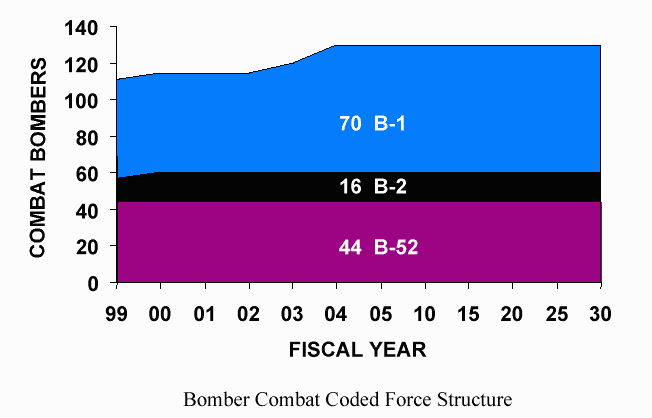
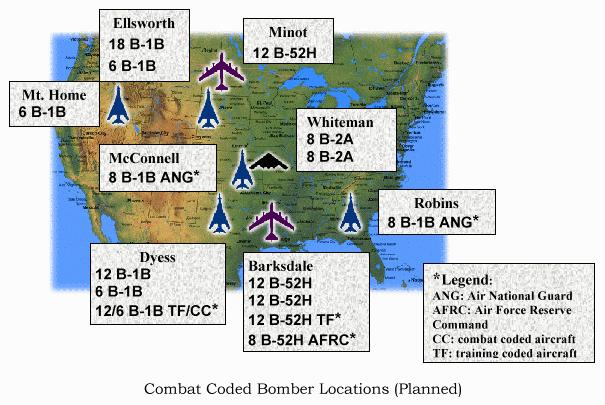
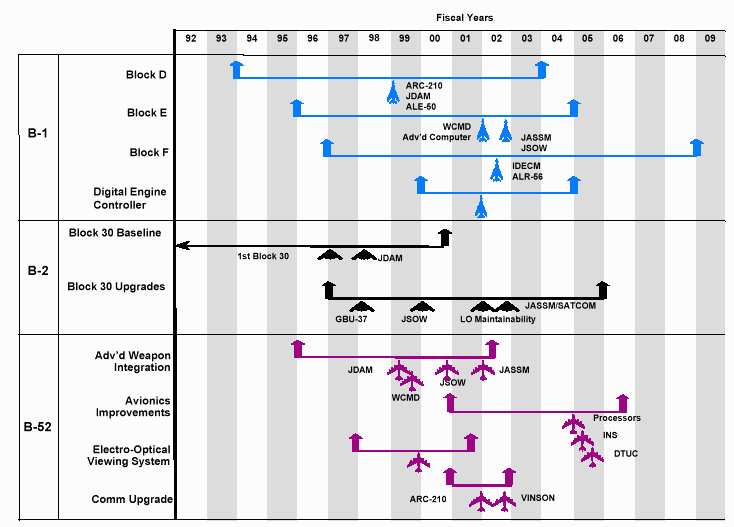 Early in the next century, the bomber fleet will see the fruition of the
plans described by the Air Force’s ‘92 Roadmap, including the transition of the
bomber force from a cold war instrument to a flexible response force. Consistent with the LRAP findings and the Defense Science Board’s 1998 Summer Study Task
Force Report, the Air Force is making significant near through long term investments in integrating precision munitions, enhancing connectivity and mission planning
responsiveness, and increasing bomber sortie rates. To this end, the Air Force
has already invested $3.6 billion in new combat capabilities and reliability and
maintainability upgrades, along with budgeting for $22.6 million in
bomber Forward Operation Location (FOL) requirements.
The significant
conventional modernization effort outlined in the 1992 Bomber Roadmap has
produced three large payload, long-range “bomber” platforms now able to
conventionally destroy multiple targets per sortie - creating desired effects at
the strategic, operational, and tactical levels simultaneously. By 2000 all three bombers will have large payload Joint Direct Attack Munition (JDAM) near-precision delivery capability. The bomber arsenal will also have impressive B-52 stand-off weaponry and Joint Stand-Off Weapon (JSOW) capability on-board the B-2. These enhancements have merged precision, stealth, and stand-off with the payload, range and responsiveness of the bomber arsenal. Bombers are now a critical element of a joint conventional aerospace team with unique capabilities to fulfill Commander-in-Chief (CINC) requirements across the full spectrum of conflict.
Early in the next century, the bomber fleet will see the fruition of the
plans described by the Air Force’s ‘92 Roadmap, including the transition of the
bomber force from a cold war instrument to a flexible response force. Consistent with the LRAP findings and the Defense Science Board’s 1998 Summer Study Task
Force Report, the Air Force is making significant near through long term investments in integrating precision munitions, enhancing connectivity and mission planning
responsiveness, and increasing bomber sortie rates. To this end, the Air Force
has already invested $3.6 billion in new combat capabilities and reliability and
maintainability upgrades, along with budgeting for $22.6 million in
bomber Forward Operation Location (FOL) requirements.
The significant
conventional modernization effort outlined in the 1992 Bomber Roadmap has
produced three large payload, long-range “bomber” platforms now able to
conventionally destroy multiple targets per sortie - creating desired effects at
the strategic, operational, and tactical levels simultaneously. By 2000 all three bombers will have large payload Joint Direct Attack Munition (JDAM) near-precision delivery capability. The bomber arsenal will also have impressive B-52 stand-off weaponry and Joint Stand-Off Weapon (JSOW) capability on-board the B-2. These enhancements have merged precision, stealth, and stand-off with the payload, range and responsiveness of the bomber arsenal. Bombers are now a critical element of a joint conventional aerospace team with unique capabilities to fulfill Commander-in-Chief (CINC) requirements across the full spectrum of conflict.
Sources and Resources
http://www.fas.org/nuke/guide/usa/bomber/overview.htm
Maintained by Webmaster
Updated Thursday, April 22, 1999 8:11:26 AM












